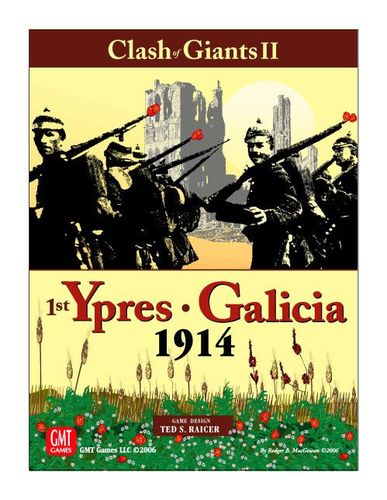|
Advertisement
|
Clash of Giants II: 1st Ypres & Galicia 1914

DescriptionClash of Giants II: The Campaigns of Galicia and First Ypres, 1914 is the sequel to Ted Raicer's acclaimed Clash of Giants: Campaigns of Tannenberg and the Marne, 1914. As with the original design, CoG II contains two separate games (both using the same basic system) covering two of the most interesting (and least-gamed) campaigns of the First World War, Galicia and First Ypres . Galicia 1914 pitted the armies of Tsarist Russia and Habsburg Austria-Hungary in a ferocious struggle along a 200 mile front. The Austrian commander, General Conrad, refused to wait for the arrival of his 2nd Army, which had been initially deployed to the Serbian front, before going onto the offensive. The Austrian attack began on 19 August, with Conrad's 1st and 4th Armies on the Austrian left flank striking the Russian 4th and 5th Armies on the Tsarist right. The Austrians outnumbered the Russians on this flank, and initially drove them back, and Conrad began to dream of pocketing the entire Russian army group. But the absence of the Austrian 2nd Army gave the Russians an even greater numerical advantage on the opposite flank, as two Russian armies (the 3rd and 8th) struck the Austrian 3rd east of Lemberg (Lvov). Soon it was Conrad's armies that were in danger of being cut off and destroyed. The campaign was a catastrophe for Austria-Hungary, but in the end the result was a fatally incomplete victory for the Russians. The First Ypres game is the first game to cover the climax of the "Race to the Sea" on the Western Front that followed the inconclusive Allied victory at the Marne. By 8 October the continued outflanking attempts by both sides had nearly reached the English Channel. A massive meeting engagement developed, with the Germans first attempting to launch a massive cavalry raid around the Allied northern flank in the direction of Abbeville. When this fizzled (due to the timely arrival of a French infantry corps), the French and British began their own offensive aimed at driving all the way to the German border. But the Allied attack quickly ran into German troops of the 6th Army, hurried north from Alsace-Lorraine. Falkenhayn, the German commander, now planned to play his trump card, striking the BEF with four newly-raised reserve corps of hurriedly-trained but enthusiastic volunteers. In a month of brutal struggle in which the British lost 60,000 men, the Germans lost well over 100,000. Not realizing that the BEF had been bled white and was on the point of breaking, Falkenhayn called off his attacks in mid-November. The attempts to end the war by Christmas were over. Clash of Giants II uses a slightly modified version of the original system to model these dynamic and closely balanced contests. As in Clash of Giants, the game emphasizes the difficulty of commanding groups of armies, with a system where movement allowance for each army is separately determined by a command roll. But CoGII adds an interactive random chit-pull activation sequence, so that neither player knows which of his commands will move next. Each player has only one combat phase per turn, which he may declare at the end of any one of his command activations, but which covers the entire map. This leads to many difficult game decisions: "Do I declare combat now, with only part of my forces in position to attack, or wait hoping to get more units into the line, but risking the enemy either pulling back or striking first?" Once combat is declared, CoGII uses the unique combat system so popular in Tannenberg and Marne, in which a unit's training, equipment, and morale are factored into a Tactical Effiency Rating that often counts more than mere numbers. Galicia 1914 includes a corps/division OB and a map scaled at 9 miles to the hex that covers the entire front from Krakow to the Romanian border. The victory conditions force the Austrian player to attack initially in order to gain enough VPs to survive the strong Russian offensive certain to follow. Galicia features special rules for the great Austrian fortress of Przemysl, Russian cavalry replacements, rail supply, Offensive Support Markers (representing heavy artillery and the logistical and command preparations of a major assault), and the arrival of the Austrian 2nd Army.
(from GMT Games website) Game DiscussionsAdd CommentYou need to be logged in to comment. Insert Bullet List Please enter at least one item. Item: Item: Item: Item: Item: Insert Numeric List Please enter at least one item. Item: Item: Item: Item: Item: Insert Link Please enter the link of the website Optionally you can add display text Insert Email Please enter the email address Optionally add any display text Insert Image Please enter the link of the image Insert YouTube Video Please enter the link of the video Marketplace | ||||

Comments (0)